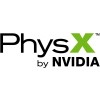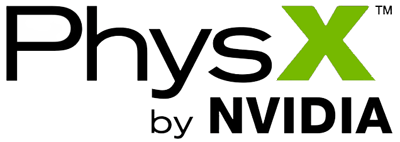- Qualcomm Launches Snapdragon 4 Gen 2 Mobile Platform
- AMD Launches Ryzen PRO 7000 Series Mobile & Desktop Platform
- Intel Launches Sleek Single-Slot Arc Pro A60 Workstation Graphics Card
- NVIDIA Announces Latest Ada Lovelace Additions: GeForce RTX 4060 Ti & RTX 4060
- Maxon Redshift With AMD Radeon GPU Rendering Support Now Available
NVIDIA’s PhysX: Performance and Status Report – Part 2

It took a little longer than expected, but NVIDIA is soon to unveil new drivers that will open up PhysX support on all 8, 9 and GTX-series of GPUs. We’ve decided to follow-up on our previous article and see where PhysX stands today, and also pit seven GPUs against the new drivers.
Page 1 – Introduction
In late June, I published the first-look we’ve had at PhysX since the acquisition by NVIDIA. Though I didn’t know it at the time, it was the first part of the series, with three parts likely to be in total. The first article happened rather quickly, because NVIDIA released a new GPU driver out of nowhere that opened up PhysX acceleration on select GPUs. I couldn’t help but test it out immediately.
Although that article happened just over a month ago, lots has happened since in the PhysX world, and we’ll be taking a look through all of it here.
One thing that impressed me with the last article is how well it performed. It quickly became one of our most popular articles this year, and that’s saying quite a bit given we were half-way through 2008. It became obvious to me just how interested gamers have become in PhysX, which is a stark contrast to how things were when AGEIA was at the helm.
Towards the end of that article, I promised to follow-up on my testing once new drivers became available, so here I am, and I’m sure you are to be pleased with what you’ll see throughout the reports. I should mention that this article was completed in a very short amount of time, so there are certain features I had to omit, which is one reason I see a part three of this article being necessary in the future.
So, what’s new with PhysX?
Gamers are not the only ones who’ve become interested in seeing PhysX progress, because as we’ll find out in this article, NVIDIA is taking the technology very seriously. Although things seemed slow post-acquisition, the company has been putting forth a lot of energy into their newfound physics accelerator, and I expect the rest of the year will be very interesting where PhysX is concerned.

For proof of their interest, look no further than the ‘NVIDIA PhysX Pack #1’ that will be released next Tuesday (ironically the same day as a certain competitor’s embargo lift). It will contain a slew of PhysX-related goodies that will set gamers off on the right foot. Here is what you’ll be able to expect:
-
NVIDIA PhysX Pack #1
- Full version of Warmonger (Though it’s always been free)
- Full version of UT III PhysX Mod Pack (Includes three PhysX-specific levels)
- Latest Ghost Recon Advanced Warfighter 2 patch (1.05)
- Sneak peek at Nurien, an upcoming social networking service, based on UE III
- Sneak peek at Metal Knight Zero, an upcoming PhysX-capable title
- “The Great Kulu” tech demo
- “Fluid” tech demo
We were told that a PhysX Pack #2 was en route, and I’m sure they’ll continue to be released as time goes on, depending on how much new PhysX content is out there. Aside from the Pack #1 itself, also released next Tuesday will be the 177.79 driver and also the PhysX software version 8.07.18. What this means is that you’ll be able to enable PhysX support on your 8, 9 or GTX-series card, no matter which model.
This is the patch we’ve all been waiting for, because it essentially blows the PhysX doors wide open for gained developer support. If all 8, 9 and GTX-series cards include PhysX support, it gives game developers all the more reason to support it, which to me, is a very good thing.
In the last article, I did a small amount of performance comparison testing, using 3DMark Vantage and Unreal Tournament III. This time I’ll be doing the same, but while also adding Ghost Recon Advanced Warfighter 2 to the mix, in addition to NVIDIA’s own Fluid techdemo and the Metal Knight Zero automated benchmark.
In this article, I will not be including certain types of testing like I did in the first one, namely due to lack of time. So, there will not be PPU comparison testing (using the AGEIA add-in card), nor will I be testing at varying game resolutions. These inclusions are not necessary, as the main focus of this article will be how each GPU scales with each other, when PhysX is brought into the picture.
One feature we still need to wait for is the ability to dedicate an installed GPU strictly for PhysX acceleration. For example, the scenario could include your SLI setup of dual 9800 GTX’s and then a single 9600 GT, which would be the card to handle PhysX computations. This would essentially ease off your big card/s to allow maximum average FPS, while leaving the minor work for the smaller GPU.
Before we jump into our performance results, please take a minute to review our system setup, as seen below. Note that we’ve tested using seven different GPUs, with another in SLI mode, which is why nothing specific is listed under video.
- Processors: Intel Core 2 Extreme QX9650 Quad-Core 3.0GHz
- Motherboard: ASUS Maximus Extreme (X38-Based)
- Memory: OCZ 2GB Titanium DDR3-1600 (@ DDR3-1333, 7-7-7-20, 1.9v)
- Video: Multiple Graphic Cards
- Sound: Onboard HD Audio
- Storage: Seagate 7200.11 500GB
- Power Supply: Corsair HX620W
- Chassis: Antec P182 Mid-Tower
- Etcetera: Windows Vista Ultimate 64-Bit
- Cooling: Corsair Nautilus 500
For tests that don’t involve PhysX acceleration, the 174.74 driver will be used, except for the 9800 GX2 and GTX 280, which both use the 177.41 driver. For all PhysX accelerated tests, the upcoming 177.79 driver is used across all cards, along with the PhysX 8.07.18 software package. That combination is what allows PhysX support on the 8, 9 and GTX-series of GPUs.
With that all taken care of, let’s start off our testing with some 3DMark Vantage.
Support our efforts! With ad revenue at an all-time low for written websites, we're relying more than ever on reader support to help us continue putting so much effort into this type of content. You can support us by becoming a Patron, or by using our Amazon shopping affiliate links listed through our articles. Thanks for your support!





